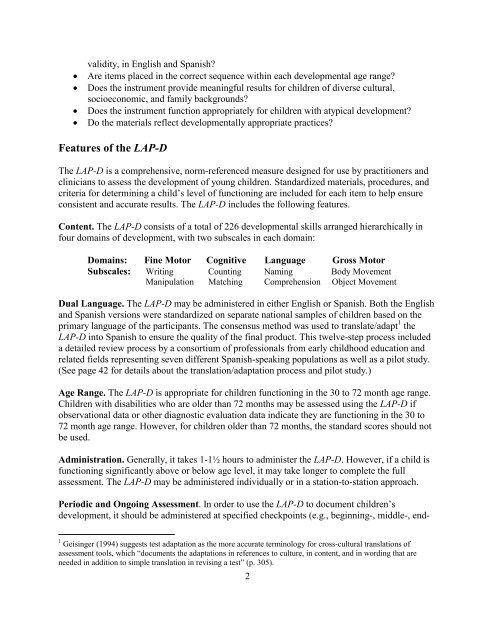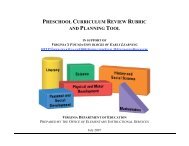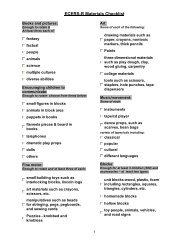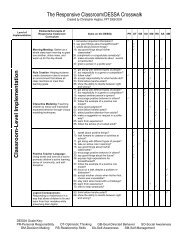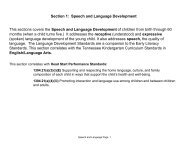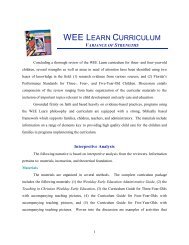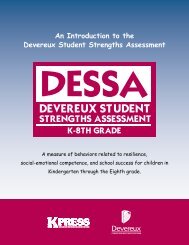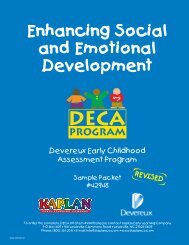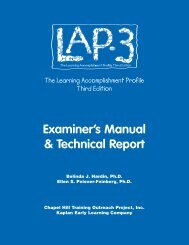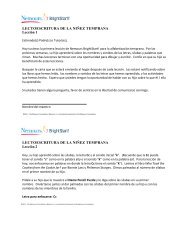validity, in English and Spanish?• Are items placed in the correct sequence within each developmental age range?• Does the instrument provide meaningful results for children of diverse cultural,socioeconomic, and family backgrounds?• Does the instrument function appropriately for children with atypical development?• Do the materials reflect developmentally appropriate practices?Features of the LAP-DThe LAP-D is a <strong>com</strong>prehensive, norm-referenced measure designed for use by practitioners andclinicians to assess the development of young children. Standardized materials, procedures, andcriteria for determining a child’s level of functioning are included for each item to help ensureconsistent and accurate results. The LAP-D includes the following features.Content. The LAP-D consists of a total of 226 developmental skills arranged hierarchically infour domains of development, with two subscales in each domain:Domains: Fine Motor Cognitive Language Gross MotorSubscales: Writing Counting Naming Body MovementManipulation Matching Comprehension Object MovementDual Language. The LAP-D may be administered in either English or Spanish. Both the Englishand Spanish versions were standardized on separate national samples of children based on theprimary language of the participants. The consensus method was used to translate/adapt 1 theLAP-D into Spanish to ensure the quality of the final product. This twelve-step process includeda detailed review process by a consortium of professionals from early childhood education andrelated fields representing seven different Spanish-speaking populations as well as a pilot study.(See page 42 for details about the translation/adaptation process and pilot study.)Age Range. The LAP-D is appropriate for children functioning in the 30 to 72 month age range.Children with disabilities who are older than 72 months may be assessed using the LAP-D ifobservational data or other diagnostic evaluation data indicate they are functioning in the 30 to72 month age range. However, for children older than 72 months, the standard scores should notbe used.Administration. Generally, it takes 1-1½ hours to administer the LAP-D. However, if a child isfunctioning significantly above or below age level, it may take longer to <strong>com</strong>plete the fullassessment. The LAP-D may be administered individually or in a station-to-station approach.Periodic and Ongoing Assessment. In order to use the LAP-D to document children’sdevelopment, it should be administered at specified checkpoints (e.g., beginning-, middle-, end-1 Geisinger (1994) suggests test adaptation as the more accurate terminology for cross-cultural translations ofassessment tools, which “documents the adaptations in references to culture, in content, and in wording that areneeded in addition to simple translation in revising a test” (p. 305).2
of-year). For example, at the beginning of the year, the LAP-D may be administered to obtain abaseline of a child’s development. As the year progresses, the LAP-D can be re-administered toexamine progress.Results. Two types of results are generated by the LAP-D—standard scores and developmentaldata on specific skills. Standard scores indicate a child’s level of skills in <strong>com</strong>parison to thestandardization sample (other children of similar ages and characteristics). Types of standardscores generated by the LAP-D are: percentile ranks, Z-Scores, T-Scores, Normal CurveEquivalents (NCE Scores), and Age Equivalent Scores. These scores can be used to understand achild’s overall development within a domain (e.g., gross motor), as well as to examine thepattern of development across domains. Such scores are often used for meeting local, state, andfederal reporting requirements. Specific skill development data shows a list of mastered andemerging developmental skills, as well as skills beyond a child’s current developmental level.This information can be used to develop short-term, individualized instructional plans andobjectives. Such information is also useful for developing an Individual Education Program(IEP) or an Individualized Family Service Plan (IFSP) for children with disabilities.<strong>Technical</strong> Qualities. A sample of 2099 children participated in the LAP-D standardization study,1124 English-speaking children and 975 Spanish-speaking children. A stratified samplingprocedure was used based on language, geographic region, age, race, gender, and type of setting.The results suggest that the LAP-D is a reliable and valid measure for assessing the skilldevelopment of both English- and Spanish-speaking children. Study results indicate strongcorrelations (.74 to .90) between chronological age and raw scores for the domains andsubscales. Good reliability based on test-retest correlations is indicated for both the Englishspeakingsample domain (.95 to .97) and subscale (.88 to .96) levels and on the Spanish-speakingsample domain (.93 to .95) and subscale (.86 to .94) levels. In addition, good interrater reliabilityis indicated for both the English-speaking sample domain (.90 to .93) and subscale (.82 to .93)levels and the Spanish-speaking sample domain (.86 to .94) and subscale (.72 to .92) levels.Construct and criterion validity results also indicate that the LAP-D is valid when <strong>com</strong>pared withother established instruments. See Chapters 5 and 6 for detailed information about the LAP-Dtechnical qualities.Assessment Materials. The LAP-D Assessment Kit contains all of the materials necessary foradministering and scoring the LAP-D in both English and Spanish, except for a fewenvironmental items (e.g., stairs, chairs). In addition, <strong>com</strong>puter scoring assistant software isavailable in web, <strong>com</strong>puter, and PDA formats. LAP-D Planning Cards and a video are alsoavailable. See page 11 for detailed information about LAP-D materials.Differences between the LAP-D Second Edition (1992) and the LAP-D ThirdEdition (2005)The purpose of this study was to re-examine the psychometric properties of the LAP-D, to renormthe English version, and to translate and establish norms for the Spanish version.Therefore, to the extent possible, minimal changes to the instrument were made. For example,3
- Page 3 and 4: Initial DevelopmentDavid Wilson LeM
- Page 6 and 7: About the AuthorsBelinda J. Hardin
- Page 8 and 9: Interpreting LAP-D Profiles........
- Page 12 and 13: the LAP-D Third Edition is comprise
- Page 15 and 16: Chapter 2Overview of the LAP-DThis
- Page 17 and 18: egression procedures. This study ex
- Page 19 and 20: Table 1. Subscales of the LAP-DDoma
- Page 21: LAP-D Scoring Booklet. The Scoring
- Page 24 and 25: ecomes inattentive or severely dist
- Page 26 and 27: --When borrowing a month, borrow 30
- Page 28 and 29: Determining Starting PointsOnce the
- Page 30 and 31: Scoring Procedures RulesOnce the st
- Page 32 and 33: Figure 3a. Determining the BasalJOR
- Page 34 and 35: Ceiling RulesThe child’s ceiling
- Page 36 and 37: Additional Scoring Rules1. Administ
- Page 38 and 39: Figure 5. Computing Raw ScoresDEVAG
- Page 40 and 41: complete the Scoring Summary & Prof
- Page 42 and 43: Figure 7: Shanika’s Scoring Summa
- Page 44 and 45: Figure 9: Alan’s Scoring Summary
- Page 46 and 47: Communicating Assessment Results to
- Page 48 and 49: of training and experience required
- Page 50 and 51: sessions, one to three weeks apart,
- Page 52 and 53: Changes were made to the translatio
- Page 54 and 55: 60-65 months 183 62.4 001.8 194 62.
- Page 56 and 57: Table 6. Adults and Number of Child
- Page 58 and 59: Prior to selection of the criterion
- Page 60 and 61:
additional 409 children (19.5%; n=2
- Page 62 and 63:
means, standard deviations, and cor
- Page 64 and 65:
• Comprehension30-35 months 99 08
- Page 66 and 67:
Table 12b. Internal Consistency of
- Page 68 and 69:
Table 13b. Standard Errors of Measu
- Page 70 and 71:
Test-retest reliability was determi
- Page 72 and 73:
speaking children, 8.62% were Black
- Page 74 and 75:
Table 17b. Means, Standard Deviatio
- Page 76 and 77:
Table 18b. Zero-order Correlations
- Page 78 and 79:
Table 20. Correlations Between LAP-
- Page 80 and 81:
Table 23 depicts the means, standar
- Page 82 and 83:
Age Equivalent ScoresAn age equival
- Page 85 and 86:
ReferencesAmerican Educational Rese
- Page 87 and 88:
Errata for theExaminer’s Manual &
- Page 89 and 90:
Table A-1. Percentile Rank, NCE, t-
- Page 91 and 92:
Table B-2. Percentile Ranks for LAP
- Page 93 and 94:
Table B-4. Percentile Ranks for LAP
- Page 95 and 96:
Table B-6. Percentile Ranks for LAP
- Page 97 and 98:
Table B-8. Percentile Ranks for LAP
- Page 99 and 100:
Table B-10. Percentile Ranks for LA
- Page 101 and 102:
Table B-12. Percentile Ranks for LA
- Page 103 and 104:
Table B-14. Percentile Ranks for LA
- Page 105 and 106:
30-35 MONTHS 36-41 MONTHS 42-47 MON
- Page 107 and 108:
30-35 MONTHS 36-41 MONTHS 42-47 MON
- Page 109 and 110:
Table C-1. Percentile Ranks for LAP
- Page 111 and 112:
Table C-3. Percentile Ranks for LAP
- Page 113 and 114:
Table C-5. Percentile Ranks for LAP
- Page 115 and 116:
Table C-7. Percentile Ranks for LAP
- Page 117 and 118:
Table C-9. Percentile Ranks for LAP
- Page 119 and 120:
Table C-11. Percentile Ranks for LA
- Page 121 and 122:
Table C-13. Percentile Ranks for LA
- Page 123 and 124:
Table C-15. Percentile Ranks for To
- Page 125:
Table C-16. Spanish Age Equivalents


